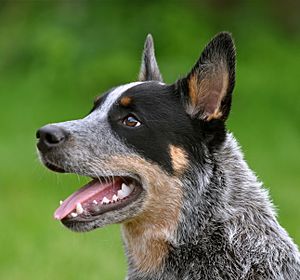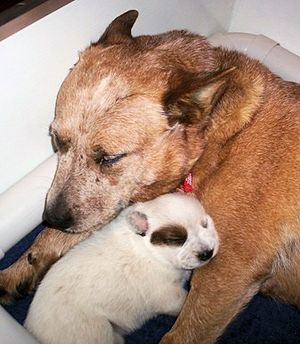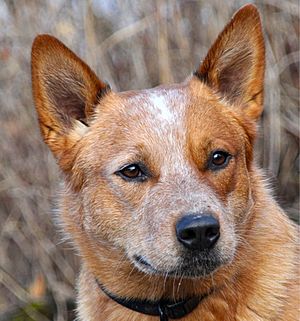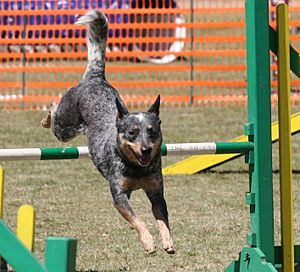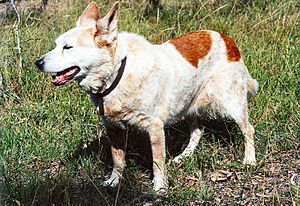Australian Cattle Dog facts for kids
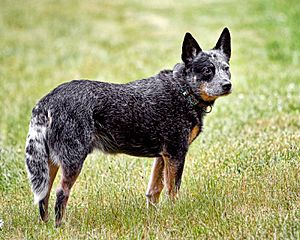
A blue Australian Cattle Dog
|
||||||||||||||||||||||||||
| Other names | ACD, Cattle Dog, Blue Heeler, Red Heeler, Queensland Heeler | |||||||||||||||||||||||||
|---|---|---|---|---|---|---|---|---|---|---|---|---|---|---|---|---|---|---|---|---|---|---|---|---|---|---|
| Origin | Australia | |||||||||||||||||||||||||
|
||||||||||||||||||||||||||
|
||||||||||||||||||||||||||
| Domestic dog (Canis lupus familiaris) | ||||||||||||||||||||||||||
The Australian Cattle Dog (often called ACD or just Cattle Dog) is a special type of herding dog. It was first developed in Australia. Its main job was to help move cattle over long distances and across tough land.
This dog is medium-sized and has a short coat. It comes in two main colors: "red" or "blue." These colors come from brown or black hairs mixed evenly through a white coat.
Like other working dogs, the Australian Cattle Dog is very energetic and smart. It can be a bit independent. It learns well with fun and challenging training. These dogs were bred to herd by gently nipping at the heels of cattle. They might do this to running children too! They form strong bonds with their owners and can be protective. They are easy to groom, mostly needing brushing when they shed. Common health issues include deafness and some eye problems. Otherwise, they are strong dogs that usually live 12 to 14 years.
In the 1800s, a farmer named Thomas Hall in New South Wales mixed his family's herding dogs with tamed dingoes. These new dogs were called Hall's Heelers. After Hall passed away in 1870, these dogs became more widely available. They later became the Australian Cattle Dog and the Australian Stumpy Tail Cattle Dog. A person named Robert Kaleski helped a lot in developing the breed and wrote its first official description.
The Australian Cattle Dog is sometimes called a "Red Heeler" or "Blue Heeler." This is because of their color and how they nip at cattle's heels to move them. Dogs from a successful line in Queensland, Australia, were called "Queensland Heelers." Now, this name is sometimes used for any Australian Cattle Dog.
Contents
What Does an Australian Cattle Dog Look Like?
Body and Build
The Australian Cattle Dog is a strong, muscular, and compact dog. It looks agile and powerful. Its head is broad and flattens between the eyes. It has strong cheeks and a medium-length, powerful snout. The ears are small to medium, stand up straight, and are set wide apart. Their eyes are dark and oval, showing an alert and keen look. The neck and shoulders are strong. Their front legs are straight, and their feet are round with small, strong toes and nails.
The breed standard says that the Australian Cattle Dog should have good muscles. Even if they are pets or show dogs, they should look balanced. No part of the dog should look too big or too small. They should not look too delicate or too heavy. This is because a working dog needs to be agile and have lots of energy.
How Big Are They?
Female Australian Cattle Dogs are usually about 43–48 centimetres (17–19 in) tall at the shoulder. Males are a bit taller, around 46–51 centimetres (18–20 in). Their body should be a bit longer than they are tall. So, the length from their chest to their rear is more than their height. A healthy Australian Cattle Dog weighs about 18–25 kilograms (40–55 lb).
Coat and Colors
There are two main coat colors: red and blue. Other colors like chocolate or cream are not typical for the breed.
Blue dogs can be blue, blue mottled (mixed colors), or blue speckled. They often have tan markings on their legs and chest. They might also have white markings and a black patch or "mask" around one or both eyes. Sometimes, black patches appear on their body too.
Red dogs are evenly speckled with solid red markings. Like blue dogs, they can have a brown (red) patch or "mask" around one or both eyes. They might also have red patches on their body.
Both red and blue puppies are born white. Their red or black hairs start to show around 4 weeks old as they grow. The unique adult color comes from black or red hairs mixed closely with a mostly white coat. This is not the "merle" pattern, which can cause health issues. Instead, it's from a special gene that creates speckles of color.
Australian Cattle Dogs also have some solid color patches. The most common are masks over their eyes, a white tip on their tail, and a solid spot at the base of their tail. Sometimes they have solid spots on their body, but these are not preferred for show dogs. Blue dogs can have tan color halfway up their legs, extending to their chest and throat, with tan on their jaws and eyebrows.
Both colors can have a white "star" on their forehead. This is called the "Bentley Mark."
The Australian Cattle Dog has a double coat. The outer layer has short, straight hairs that protect them from the weather. The inner layer is short, fine, and thick.
The "mask" is a black patch over one or both eyes for blue dogs, or a red patch for red dogs. If only one eye has a patch, it's a "single" or "half" mask. If both eyes have patches, it's a "double" or "full" mask. Dogs without a mask are called plain-faced. All these are fine according to the breed standard. For dog shows, even markings are usually preferred.
Tail
The official rules for the Australian Cattle Dog say they should have a natural, long tail that is not cut short. They often have a solid color spot at the base of the tail and a white tip. The tail should hang in a slight curve when the dog is resting. When excited, the dog might carry its tail higher. The tail should have a good amount of hair.
In Australia, tails are not cut. A long tail helps the dog turn quickly and be more agile. The Australian Cattle Dog is different from the Australian Stumpy Tail Cattle Dog. The Stumpy Tail is born with a naturally short tail. It looks similar but is taller and leaner.
Personality and Behavior
Temperament
Like many working dogs, the Australian Cattle Dog has lots of energy and a busy mind. They are also quite independent. This breed is ranked as one of the smartest dogs for training obedience commands.
Cattle Dogs need plenty of exercise, companionship, and something to do. If they don't have a job, they might get into mischief! A pet Cattle Dog might enjoy dog sports, learning tricks, or other activities that challenge their body and mind.
At home, the Australian Cattle Dog is loving and playful. However, they are careful around strangers and in new situations. This makes them good guard dogs if trained. It's good to introduce them to many different people when they are young. They are good with older, thoughtful children. But they might try to herd people by nipping at their heels, especially younger kids who run and make noise.
Australian Cattle Dogs usually work quietly. But they will bark to warn you or get attention. They have a distinct, high-pitched bark. Barking can mean they are bored or frustrated. They get along well with dogs they know. But if many dogs are together, they might try to establish who is in charge, which can cause problems. They are not a breed that lives well in a large pack with other dogs.
Caring for Your Cattle Dog
Grooming Needs
The Australian Cattle Dog is known as a "wash and wear" dog because it needs very little grooming. Just brushing them now and then is enough to keep their coat clean and free of smells. Even for dog shows, they just need a wipe down with a damp cloth.
They don't shed all year. They "blow their coat" once a year (or twice for female dogs that have not been spayed). During this time, frequent brushing and a warm bath will help control the shedding hair. Like all dogs, regularly checking their nails, ears, and teeth helps prevent health problems.
Training Your Cattle Dog
Training an Australian Cattle Dog is about teaching them what you want them to do. It's also about showing them that it's worth their while to do it! This breed is smart and responds well to training. This is great if you have a structured and varied training plan. But if training is not consistent or is boring, they might develop unwanted behaviors.
Many natural behaviors of a Cattle Dog, like barking, chewing, chasing, digging, and nipping heels, are not ideal for a pet. So, training helps them learn a lifestyle that is different from their herding ancestors. The Australian Cattle Dog is eager to please and learns quickly.
Fun Activities for Your Cattle Dog
Australian Cattle Dogs need a lot of physical activity. Like many herding dogs, they have active minds. If they don't have jobs to do, they will find their own activities! A walk around the neighborhood is nice, but they need more. They need structured activities that challenge them and regular playtime with their owner.
This breed is great for any activity that needs athleticism, intelligence, and endurance.
Kennel club events like herding trials are perfect for the Cattle Dog's natural herding skills. They were bred to encourage cattle to move long distances. Some people think they are the best breed in the world for this job.
One very popular activity for Australian Cattle Dogs is dog agility. They are perfect for obstacle courses. As herding dogs, they pay close attention to their handler's body language and can work well from a distance. Agility can also help build confidence in these dogs.
Australian Cattle Dogs love new experiences. They can do very well in obedience competitions. They enjoy challenges like finding a scented item. But because they are so good at solving problems, they might find their own ways to do things that judges might not reward! Rally obedience offers more interaction with the owner and less repetition.
Cattle Dogs have also done well in sports like weight pulling, flyball, and schutzhund. They are especially good at activities they can share with their owner, such as canicross (running with your dog), disc dog (frisbee), and skijoring or bikejoring (being pulled by your dog while skiing or biking). They make great hiking companions because they have lots of endurance. They usually don't hunt and prefer to stay close to their owner. Most Australian Cattle Dogs love water and are excellent swimmers.
They are not hyperactive dogs. Once they've had their exercise, they are happy to relax at their owner's feet. The Australian Cattle Dog can adapt to city or indoor living, as long as they get enough exercise and attention.
Australian Cattle Dogs can also work in many ways. Some are service dogs for people with disabilities or therapy dogs. Some work for customs agencies. Others are police dogs. Some help control pest animals like geese. And some even track endangered wildlife by finding their scat (poop).
Health and Life Expectancy
Lifespan
Australian Cattle Dogs generally live a long time. In one study, they lived for about 11.7 years on average, with some living up to almost 16 years. Another study found an average lifespan of 13.41 years. Dogs of similar size usually live between 11 and 13 years.
There's a famous story about a Cattle Dog named Bluey who supposedly lived for 29.5 years! While this is an amazing story, it's very rare and not typical for the breed. However, Australian Cattle Dogs do tend to age well. Many are still active at 12 or 14 years old. Some even keep their sight, hearing, and teeth until their last days.
Related Pages
Images for kids
-
US soldiers met the Cattle Dog mascots of Australian divisions overseas. This puppy is being bathed in preparation for a visit by General Douglas MacArthur.
See also
 In Spanish: Pastor ganadero australiano para niños
In Spanish: Pastor ganadero australiano para niños


